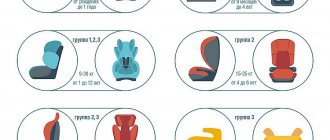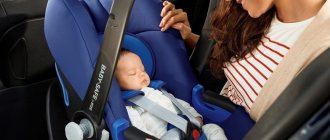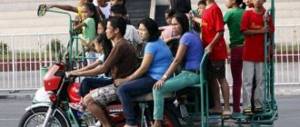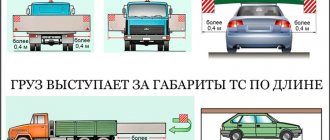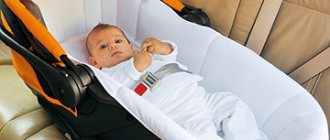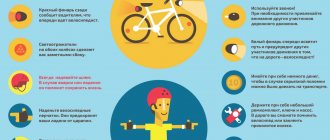Good afternoon, dear reader.
Previously, pddmaster.ru had already published an article in which the rules for transporting children in cars were discussed in detail.
However, many readers have questions about whether it is possible to carry a child in the front seat of a car in 2021. Therefore, today we will talk exclusively about the front passenger seats.
- At what age can a child ride in the front seat?
- Child in a car.
- A child in the cab of a truck.
- Child on the bus.
- Airbag deactivation.
- Fine for incorrectly transporting a child in the front seat.
Let's get started.
First of all, let's look at clause 22.9 of the 2021 traffic rules. This is where we talk about transporting children:
22.9. Transportation of children under the age of 7 years in a car and a truck cab that is designed with seat belts or seat belts and an ISOFIX child restraint system must be carried out using child restraint systems (devices) that are appropriate for the weight and height of the child.
Transportation of children aged 7 to 11 years (inclusive) in a passenger car and truck cab, which are designed with seat belts or seat belts and an ISOFIX child restraint system, must be carried out using child restraint systems (devices) that are appropriate for the weight and height of the child , or using seat belts, and in the front seat of a car - only with the use of child restraint systems (devices) corresponding to the weight and height of the child.
Child in a car
Most often, parents transport their children in private cars. Please note that category B includes not only passenger cars, but also small trucks. For them, the transportation rules are different and they will be discussed below.
| Age | Conditions of transportation |
| from 0 to 11 years | Only using a child restraint |
| from 11 to 18 years old | Using standard seat belts |
What devices can be used to transport children
TRANSPORT SERVICE 8-961-306-306-1
The cost of transportation by gazelle in Rostov-on-Don starts from 350 rubles per hour, minimum 2 hours. The cost depends on the modification of the vehicle used to transport the cargo, as well as on the distance that needs to be covered.
We recommend reading: Will discounted travel be returned to veterans of labor in Chuvashia in 2021?
Gazelle intercity , price per kilometer:
How much does it cost to transport cargo by gazelle intercity? The cost of freight transportation up to 2 tons intercity is 11-13 rubles/km, round trip. The cost per km depends on the distance of the trip; when making a long trip, the cost per kilometer will be 11 rubles.
Child in the cab of a truck
This section deals with trucks of all types. Starting with multi-ton tractors and ending with light trucks based on cars.
What is of fundamental importance is not the appearance and size of the car, but the information specified in the “Vehicle Type” field of the registration certificate. If the value “truck” is entered in this field, then the following rules should be used:
| Age | Conditions of transportation |
| from 0 to 7 years | Only using a child restraint |
| from 7 to 11 years | Using a child restraint or seat belt |
| from 11 to 18 years old | Using standard seat belts |
Changes to the rules for transporting children in a car in questions and answers
The fine for not having a child seat varies depending on who committed the offense:
| Responsible person | Amount of fine in rubles |
| Driver (Parents, relatives) | 3 000 |
| Officials – educators, teachers, taxi drivers | 25 000 |
| Legal entities – school, taxi company | 100 000 |
It is possible to pay the fine with a 50% discount within 20 days from the date of delivery of the decision to the citizen.
Most often, difficulties with the law on child seats arise in large families. One car can comfortably accommodate two, rarely three, seats, but without them all four or even five children could fit in the back seat.
Another drawback is the imposition of fines on taxi drivers. Sometimes parents deliberately do not warn that there will be a child in the cabin, so as not to increase the cost of the trip. When an inspector stops a car, the blame falls on the taxi driver. In extreme cases, the fine for parents will be 3,000 rubles, and for the driver – 25,000.
Types of car seats for children on the Russian market:
| Child's age | Restraint type | Weight in kg. | Group (class) car seats |
| from birth to 1 year | Carrying or “cradle”. They are installed in the car in one of two positions: horizontal, in which the child can sleep in the car, vertical, in which the baby is held using a special belt. | to 10 | 0 |
| up to 1.5 years. Can be used for children from the first day of life. | Armchair. The child in it is in a “reclining” state. The device can be positioned either with your back or facing the direction of travel. | up to 13 | 0+ |
| from 1 year to 4 years | Armchair. Installation can only be done in the direction of travel of the vehicle. The child is secured using durable, five-point harnesses. | 9-18 | 1 |
| from 3 to 7 years | Armchair. Standard seat belt. The chair has an adjustable backrest that can be adjusted to the height of the child. | 15-25 | 2 |
| from 7 to 12 years | Seat without backrest. The child is held in place by an additional seat belt. | up to 36 | 3 |
Each type of seat is used only for children of a certain age. Some car seats, for example, categories 0 and 0+, are adjustable depending on the child’s height and weight, but from 1.5 years old it is necessary to purchase a larger seat.
When purchasing a child seat for your car, there are a few things to consider:
- Type of belt fastening. There are two types of fastenings: standard and improved - ISOFIX. Both options are suitable for passing a traffic police check, but the ISOFIX system is more reliable in the event of an accident.
- Seat belts on the seat. Small children must be secured in the bassinet. Special built-in belts are designed for this - three- or five-point. Fixing with a safety table is also possible. The best option is a five-point harness.
- Chair frame. The most durable and reliable is the aluminum frame, as opposed to plastic.
- You should choose those models that are equipped with a durable, large headrest and sides.
- Preference should be given to covers made of cotton fabric, as they are better suited to the baby's skin and do not irritate it.
- By car and driver
- By resolution number
Child on the bus
This section deals with buses of all types, i.e. about vehicles with more than 8 passenger seats. The size of the vehicle, again, does not matter. The buses can be either small minivans or huge tourist buses.
| Age | Conditions of transportation |
| from 0 to 18 years | Using standard seat belts |
Let's look at an interesting example. Gazelle minibuses have become widespread in Russia. Moreover, they are available in various modifications.
The registration certificate may indicate the following vehicle type options:
- cargo van;
- bus (other buses).
Externally, Gazelles of different modifications are similar to each other, but the rules for transporting children in the front seat differ. On a bus, a child of any age can be fastened with a regular seat belt, but on a cargo van, a child restraint system is required for children under 7 years of age.
Is it possible to transport a child in the front seat?
A child who is not restrained and not in a car seat cannot be the reason for fines if the car is not moving.
A child who is under twelve years old, but is taller than 150 cm and weighs more than 36 kg, fastened in the back seat with standard seat belts, does not violate the safety standards prescribed by the traffic rules.
If a traffic police inspector stops an ordinary driver who is transporting a small child in his car without a seat, then he faces liability under Article 12.23 of the Code of Administrative Offenses and a fine of 3,000 rubles.
It’s another matter if such a violation is committed by a taxi who is engaged in his activity professionally and has the appropriate permits and travels in a taxi car.
In this case, the driver may be charged under Article 238 of the Criminal Code of the Russian Federation - “Provision of services that do not meet the requirements for the safety of life or health of consumers.”
- Under the first part of this article, you can receive a fine of up to 300 thousand rubles , or restriction of freedom or even imprisonment for up to 2 years.
- According to the second part of the same article, if the case involved children under 6 years of age, or the consequences were the infliction of serious harm or the death of a person, the sanctions for the driver will be even tougher. The fine for a child without a car seat in a taxi is from 100 to 500 thousand rubles , or imprisonment for up to 6 years (!), with a fine of up to 500 thousand rubles.
- Part three of Article 238 of the Criminal Code of the Russian Federation is the most stringent and is applied if, for example, an accident results in the death of two or more persons. Sanction: up to 10 years in prison.
That is, if, for example, a taxi driver has an outstanding criminal record, and if he is caught violating Part 1 of Art. 238 of the Criminal Code of the Russian Federation (simply transporting a child without a seat), then the judge can easily send him to jail, according to the law.
Even worse, if an accident occurs (even if the taxi driver was not at fault, they drove into him) and it turns out that the taxi driver was transporting children with disabilities, and they, God forbid, were injured, the corresponding article of the Criminal Code will inevitably be applied to the driver.
The law of the Russian Federation allows minor passengers to be transported in the front seat of a vehicle, provided that all transportation rules are followed. One of these rules is the presence in the car of a special child restraint device (CCD), in which the passenger must be seated while the vehicle is moving.
It must also comply with GOST and the physical parameters of the young passenger, namely height and weight. Failure to comply with this requirement can lead to injury to a minor in the event of an accident, and is also considered by traffic police inspectors as an offense.
Despite the fact that it is legal to carry minors in the front, many parents do not risk installing a child restraint system near the front panel of the car. This opinion is justified by the fact that the seats located in the back are much safer than the front ones, so not every parent is ready to expose their child to possible risk.
Accidents caused by a head-on collision are the most dangerous type of car accidents. In these transport accidents, people sitting in the front primarily suffer, but passengers sitting in the back are more protected from various injuries and damages.
Therefore, by installing a child restraint system in the front, a small person is more likely to be seriously injured in the event of a car accident.
Changes have been made to clause 12.8 of the traffic rules regarding the prohibition of leaving children under 7 years old in a car without adult supervision. In this case, the time during which personal transport is stopped is important. If no more than 5 minutes, then you can leave the child alone.
Violation of this clause entails a fine on the driver in the amount of 2.5 thousand rubles for Moscow and St. Petersburg and 500 rubles for other regions.
What is meant by the term “special restraint device”? It can be either a car seat corresponding to the child’s age and weight category, or a booster. A child car seat for children under 7 years of age must be equipped with seat belts. Older children can be secured with standard seat belts and additionally use a booster. When placing a small passenger in the front seat, special securing devices are required.
When installing a car seat in the front seat, the airbag must be turned off.
Newborn children can travel in vehicles only in car bassinets or special-type baby carriers. Such devices are designed for a child up to 12 months old and a maximum weight of up to 13 kg. They are usually labeled category 0 or 0+.
Traveling in a car with a child from one to 7 years old (or in the cabin of a truck) is possible using car seats of categories 1,2 or 3, depending on the height and weight of the child. When fixing the seat, standard seat belts or the ISOFIX system can be used. The safety and security of the child must be ensured by its own soft belts built into the structure of the car seat.
Moving older children in cars is subject to the standards approved for the adult category of citizens.
Passengers over 12 years of age can be secured in any seat of the car using the belts that the car is equipped with. Other devices that ensure maximum safety when traveling on the roads are acceptable. The legislation does not oblige drivers to use special devices for children over 12 years of age.
The traffic rules establish the procedure for transporting children in a car. To ensure their safety, restraint devices are used in accordance with their age category.
When transporting a child in the back seat of a car, the following rules apply:
- a child under 7 years of age is transported in a special car seat equipped with seat belts and secured in the back seat;
- Over 7 years of age, a child can be seated in a car seat or without a seat, secured with standard seat belts.
A child under 12 years old can only be transported in the front seat in a car seat.
Airbag deactivation
Most new modern cars are equipped with a passenger airbag located opposite the front passenger seat. At the same time, it is technically possible to turn off this pillow when transporting a child.
In this regard, drivers have a question: is it always necessary to turn off the airbag when installing a child seat in the front seat? Or only when the seat is installed rear-facing?
Getting an answer to this question is quite easy. You should refer to your vehicle's owner's manual and look for the section on transporting children.
In the process of writing this article, I turned to the operating manual for my car and found the following information there:
When installing a child seat on the front passenger seat in which the child sits backwards, the front passenger's front airbag must be deactivated.
Moreover, the information is duplicated on different pages of the book at least 3 times. However, nothing is said about the fact that the airbag needs to be turned off when installing the seat in the direction of travel.
Those. In my car, the airbag only needs to be turned off when the child is sitting in the seat backwards.
I recommend studying your car's manual and finding similar information there. Please note that information may vary! In some cars, the airbag must be turned off when the seat is installed in a rear-facing position, as well as when installed in a forward-facing position.
Transportation of organized groups of children by bus
(clause 15) If 2 or more buses are used for the organized transportation of a group of children, the head or official responsible for ensuring road safety of the organization, and in the case of organized transportation of a group of children under a charter agreement, the charterer appoints a senior person responsible for organized transportation of a group of children and coordination of the actions of drivers and those responsible for buses carrying out such transportation.
We recommend reading: Kak for account 205.35 in 2021
In paragraph 18 it is written that “when organizing the transportation of a group of children by bus, it is prohibited to allow persons not included in the lists provided for in subparagraph “d” of paragraph 4 of these Rules, except for an appointed medical worker, onto the bus and (or) transport on it. This prohibition does not apply to cases established by federal laws.”
